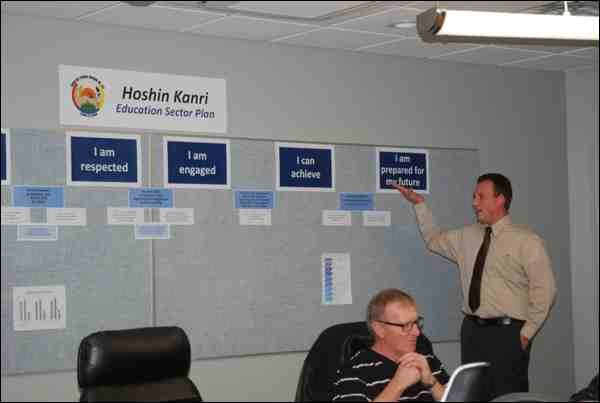Hoshin Kanri, data and "meeting at the wall." They are all part of the direction the education sector is going when it comes to meeting goals.
Last week, a "data wall" was installed in the board room of Living Sky School Division that is integral not only to setting student achievement goals, but to tracking success as those goals are pursued.
Doug Drover, data assessment consultant, told board members the data being collected by the division will provide a framework for decision making, a way to focus on where more work is needed, and indicate where successes can be celebrated. Describing the work he is doing for the division, he said his role is to slice up data in various ways, finding indicators and correlations, and to do instruction at the school level on how to make data based decisions.
The first success to be put on the data wall, said Jim Shevchuk, curriculum and instruction superintendent, was the data that shows the division's investment in the One-to-One computer program is paying off.
Luseland, Major, Spiritwood High, North Battleford Comprehensive High and Connaught Schools have been part of the One-to-One Learning program since the 2011-12 school year. Unity Public School and Cut Knife Elementary School were added in September of 2012 when they were issued 325 iPads.
Shevchuk said data from the most recent writing assessment shows a significant improvement among First Nations students in the One-to-One schools as compared to those not in One-to-One schools.
"It does show a payoff in our investment, and answers the question, 'Is what you're doing making a difference?'" said Shevchuk.
Drover said the results represent almost 50 per cent higher achievement from one group to the other.
The results speak to one of Premier Brad Wall's Vision 2020 goals for the province. Included as a goal in an education sector plan now under development is a reduction in the difference in graduation rates between aboriginal and non-aboriginal students.
The goals in the draft education sector plan were determined in a meeting in October between the 28 directors of education in Saskatchewan and Ministry of Education. They used the Hoshin Kanri process of strategic planning, which has also been used extensively by the health ministry of Saskatchewan. The process allows for the selection of a key objective, the alignment of implementation plans at all levels and for reviews and improvements to the plan on an ongoing basis.
The "I" goals developed by the process are foremost on the data wall in Living Sky School Division's board room at central office. They are things educators in the province and the provincial ministry want all students to be able to say by 2020: 'I'm ready to learn … I'm respected … I am engaged … I can achieve … I am prepared for my future."
Each of the "I" goals is accompanied by strategies to achieve them. The data collected to determine if and how they are being achieved will be posted as it is available.
About the data wall and the first success of many to be posted there, Shevchuk said, "I'm just thrilled."
Board chair Ken Arsenault said seeing the data wall up and functioning is exciting.
"I'm starting to see this all come together," he said. He was referring to various technological, instructional and assessment initiatives the division has been undertaking to serve the outcomes based curriculum that's been rolled out by the province over the past several years.
Vice-chair Ronna Pethick said she assumed every school in the division will eventually have this kind of a data wall.
"Some folks have been 'meeting at the wall' for a couple of years already," said Shevchuk.
The theory is that having the information posted, whether it's in a staff room or a hallway, people will get together to look at it and talk about it, said Director of Education Randy Fox.
Some are using data as a staff already, and some aren't, he said. But how to use data in decision-making is one piece of professional development being shared with division principals and vice-principals.
"What we're trying to do as a school division is to get all our principals and vice-principals up to the point where they understand the importance of what our data on reading, writing and arithmetic says and how [they should be] dealing with the results," said Fox.



.png;w=120;h=80;mode=crop)
